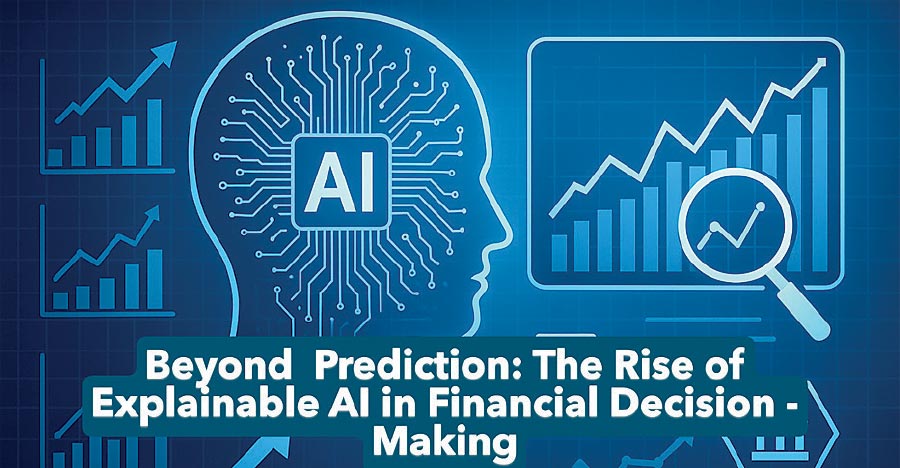Saturday Dec 06, 2025
Saturday Dec 06, 2025
Thursday, 16 October 2025 04:23 - - {{hitsCtrl.values.hits}}

 For decades, financial analysts have relied on a core set of tools and models to assess risk, predict market trends, and guide investment strategies. While these traditional methods have provided a valuable foundation, they often fall short in today’s increasingly complex and data-rich environment. The limitations of these traditional approaches are becoming ever more apparent.
For decades, financial analysts have relied on a core set of tools and models to assess risk, predict market trends, and guide investment strategies. While these traditional methods have provided a valuable foundation, they often fall short in today’s increasingly complex and data-rich environment. The limitations of these traditional approaches are becoming ever more apparent.
The limits of traditional financial analysis
Traditional financial analysis often oversimplifies complex financial realities. Models struggle to capture the nuances and interdependencies within a company’s data. Moreover, they often struggle to process the sheer volume of data available today, potentially overlooking critical signals and patterns. And, as some have pointed out, financial statements can sometimes be deliberately obfuscated (Piazza et al., 2022), making accurate analysis even more challenging. The primary focus of these traditional models has been on prediction – forecasting future performance based on historical data – without providing much insight into why those predictions are made.
The promise of AI
The rise of artificial intelligence offers a powerful new set of tools for financial analysis. AI algorithms, particularly those based on deep learning, can sift through massive datasets to identify patterns and anomalies that would be impossible for human analysts to detect (Mienye et al., 2024). AI has the potential to revolutionise financial analysis, enabling more accurate predictions, more efficient risk management, and more informed investment decisions.
The problem with “black box” predictions
However, the increasing reliance on AI in finance also raises some important concerns. Many AI models, particularly the most sophisticated ones, operate as “black boxes.” While they may be able to generate highly accurate predictions, it can be difficult or even impossible to understand how they arrived at those conclusions (Yeo et al., 2025). This lack of transparency poses several risks. “Black box” models can be susceptible to hidden biases, leading to unfair or discriminatory outcomes (Nasir & Rinaudo, 2025). Without understanding the reasoning behind a model’s predictions, it can be difficult to identify and correct these biases. Furthermore, a lack of transparency can erode trust in AI-driven financial systems. If stakeholders don’t understand how decisions are being made, they may be reluctant to accept them.
Explainable AI: A new paradigm
Explainable AI is emerging as a critical solution to the limitations of black-box models (Nasir & Rinaudo, 2025). XAI techniques aim to make AI models more transparent and understandable, allowing humans to comprehend the factors driving their predictions. By providing insights into the decision-making process, XAI can help build trust in AI systems, reduce bias, and ensure ethical and responsible use of the technology (Nasir & Rinaudo, 2025). Several different approaches to XAI are being developed, including techniques such as SHAP and LIME (Mienye et al., 2024). These methods provide insights into the importance of different features in driving a model’s predictions, helping analysts understand which factors are most influential.
Applications and the future of XAI in finance
The potential applications of XAI in finance are vast. From risk assessment and fraud detection to investment strategies and customer service, XAI can help make financial systems more transparent, accountable, and reliable. As AI continues to transform the financial landscape, XAI will play an increasingly important role in ensuring that these powerful technologies are used responsibly and ethically. Ongoing efforts are focused on making even the most complex black-box methods more interpretable (Yeo et al., 2025), paving the way for a future where AI-driven financial decisions are both accurate and understandable.
However, despite the advancements in AI and XAI, we must not overlook the irreplaceable role of human intuition in the decision-making process. While these technologies provide valuable insights, they cannot fully capture the complex dynamics of human behaviour, organisational culture, and unforeseen external factors. Human expertise, shaped by experience and nuanced understanding, remains essential for interpreting AI outputs within a broader context. Factors such as employee morale, team dynamics, subtle shifts in market sentiment and socio-political conditions are often difficult to quantify and model effectively.
Ultimately, it is human judgment that must weigh these intangible elements alongside the data-driven insights provided by AI. The most effective approach to financial decision-making will likely involve a synergistic partnership between AI and human expertise, leveraging the strengths of both to achieve superior outcomes. The rise of Explainable AI represents a fundamental shift in the way we approach financial analysis, moving beyond prediction to a new era of transparency and insight, augmented by the indispensable wisdom of human intuition.
References:
Mienye, E., Jere, N., Obaido, G., Mienye, I. D., & Aruleba, K. (2024). Deep Learning in Finance: A Survey of Applications and Techniques. AI, 5(4), 2066. https://doi.org/10.3390/ai5040101
Nasir, W., & Rinaudo, O. (2025). Future Directions in AI for the Financial Sector: Overcoming Bias and Enhancing Decision-Making with Explainable Models.
Piazza, M., Passacantando, M., Magli, F., Doni, F., Amaduzzi, A., & Messina, E. (2022). Explainable Artificial Intelligence for identifying profitability predictors in Financial Statements.
Yeo, W. J., Van Der Heever, W., Mao, R., Cambria, E., Satapathy, R., & Mengaldo, G. (2025). s10462-024-11077-7.pdf.
(Rozan Jameel holds an MBA (PIM-USJ), FCA, ACMA, BSc (Physical Science); has over 25 years of experience in the sectors of construction and engineering, retail supermarket chain, hospitality industry, import export field, automobile and education, and held positions such as Director Finance, CEO and Group CFO.)
(Dr. Susil Kumara Silva holds a PhD (Mgt. USJP), is a Sr. Lecturer, Researcher, Management Consultant; Accredited Director (SL), Chartered Member CIPM, MSLIM, CIM (UK), 26 years of managerial experience in construction and engineering, trading, apparel, manufacturing and education sectors, and held positions such as CEO, Sr. Executive Vice President and Group Head of HR and Administration in large organisations.)